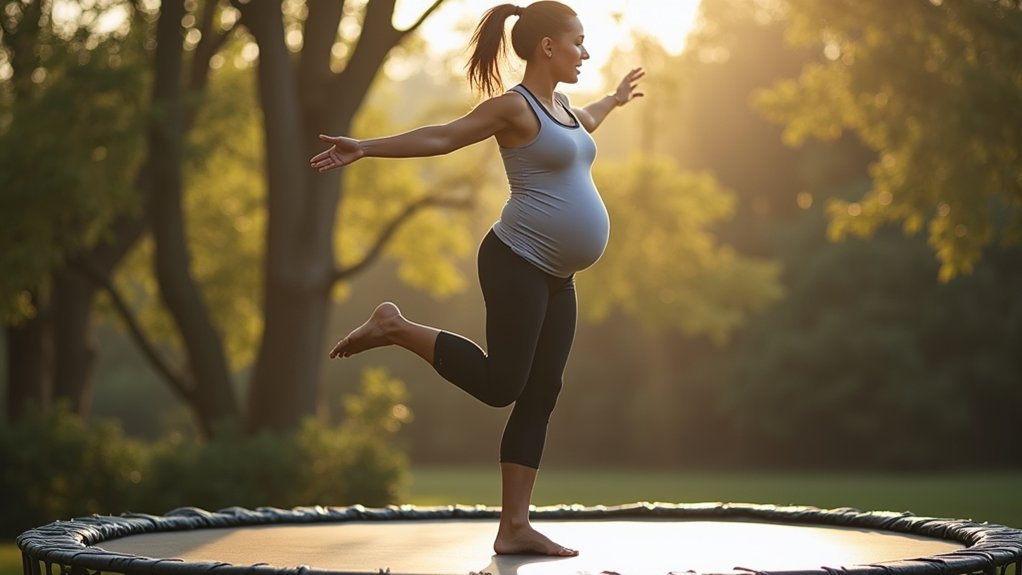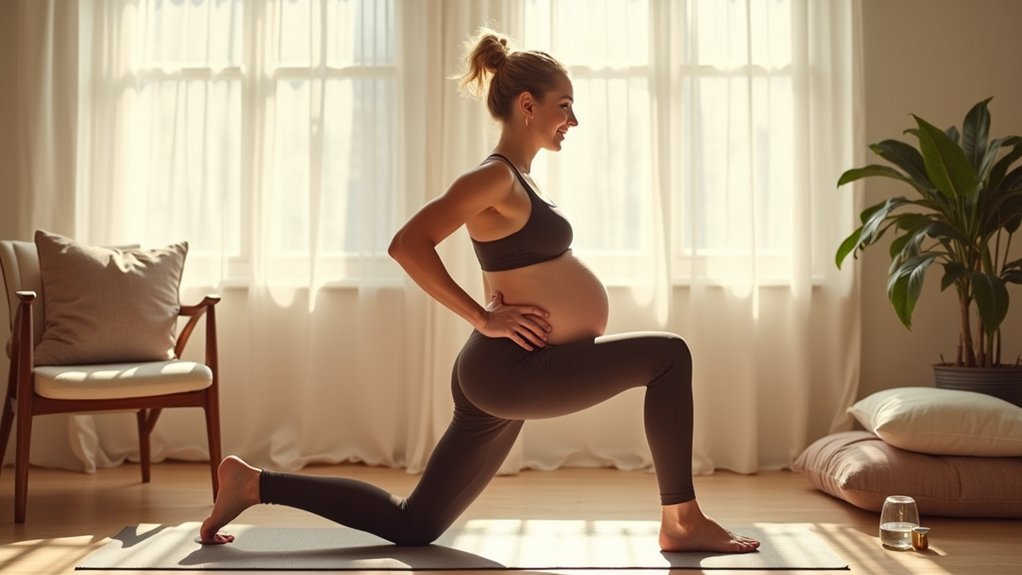While pregnant, you can modify mini trampoline workouts by slowing movements, keeping one foot on the surface, using a stability bar, and focusing on gentle marching instead of jumping. Progress from controlled stepping in early pregnancy to seated exercises in your third trimester. Always listen to your body, stop if you experience discomfort, and consult your healthcare provider before starting. These adaptations maintain fitness benefits while prioritizing safety for both you and your baby throughout each trimester.
The Benefits of Rebounding During Pregnancy

While many exercise forms need significant modification during pregnancy, rebounding offers a uniquely adaptable workout that supports your changing body. This low-impact activity improves your cardiovascular fitness while strengthening your lower limbs through gentle bouncing motions.
You’ll notice enhanced pelvic floor strength as the rhythmic bouncing creates natural loading and unloading patterns. Your balance and spatial awareness improve too, preparing you for the postural changes ahead. The endorphin release helps lower stress hormones and reduce pregnancy-related anxiety.
Research shows mothers who maintain safe exercise routines often experience shorter labors and faster postpartum recovery.
Staying active safely during pregnancy can lead to more efficient childbirth and quicker healing afterward.
When paired with proper supportive maternity wear that reduces bump bounce by up to 48%, rebounding can be continued safely throughout pregnancy with appropriate modifications as your body changes. For optimal safety, consider using low impact exercises that keep one foot on the mat at all times to minimize stress on your changing body.
First Trimester Mini Trampoline Safety Guidelines
Although pregnancy brings exciting changes, the first trimester requires special consideration for mini trampoline workouts. Your body’s hormonal shifts already affect balance and loosen joints, making falls more likely on a mini trampoline. The hormone prolactin specifically loosens your joints, creating additional instability when bouncing.
While the amniotic fluid offers some protection to your baby, falling on your stomach could lead to complications. The NHS doesn’t explicitly prohibit trampolining but cautions against activities with high fall risks.
If you’re determined to continue, guarantee proper equipment with safety features and always have someone spotting you.
However, switching to low-impact alternatives like walking, swimming, or prenatal yoga is greatly safer.
Always consult your healthcare provider before continuing or starting any exercise program. Remember that maintaining fitness during pregnancy doesn’t require risking your safety or your baby’s wellbeing.
Second Trimester Bouncing Modifications

As your pregnancy progresses into the second trimester, you’ll need to adjust your bouncing activities to accommodate your changing body.
Replace high-impact movements with controlled stepping motions – substitute jump roping with elliptical training and jumping jacks with modified step-outs.
During burpees, step back instead of jumping, and use step-ups rather than box jumps.
Always engage your transverse abdominis before any movement and synchronize your breathing with core bracing during exertion.
Activate your deep core muscles first, then coordinate breathing with abdominal engagement for safe, effective prenatal movement.
Monitor how your body responds by evaluating comfort levels and watching for signs of pelvic pressure.
If you continue any bouncing activities, shorten your range of motion to maintain stability.
Consider working with a physical therapist if you experience discomfort, and implement regular pelvic floor release stretches between workout sessions.
Remember to modify or reduce high-impact exercises throughout this trimester as your center of gravity shifts with your growing belly.
Third Trimester Low-Impact Rebounding Techniques
During the third trimester, rebounding exercises require significant modifications to accommodate your body’s advanced pregnancy changes.
Replace bouncing with controlled movements like marching in place or side-to-side weight shifts. Keep one hand on the rebounder for stability and maintain a wide stance to support your changing center of gravity.
Focus on slow, deliberate movements rather than intensity. Limit sessions to 10-15 minutes with adequate rest intervals.
Avoid lying on your back and use stabilization tools like a wall or chair for added security.
Engage your pelvic floor with gentle Kegels during movements and prioritize core stabilization with proper breathing. When performing exercises, ensure you are using a rebounder with a handlebar for safety, as balance issues can become more pronounced in the third trimester.
If you experience discomfort, switch to seated exercises or try alternatives like prenatal yoga or aquatic workouts.
Always consult your healthcare provider before continuing any exercise routine.
Proper Form and Balance for Pregnancy Trampolining

Despite its popularity as a low-impact workout, trampolining during pregnancy isn’t generally recommended by healthcare professionals. Your changing center of gravity and hormone-induced joint loosening greatly increase fall risks, which can have serious consequences for both you and your baby.
If you’re still considering mini-trampoline workouts with your provider’s approval, follow these essential guidelines:
- Keep movements slow and controlled—avoid sudden jumps or directional changes
- Always maintain proper posture with feet shoulder-width apart for stability
- Use support railings when available and never exercise unsupervised
- Stop immediately if you experience dizziness, discomfort, or feel off-balance
Most experts suggest that activities with high risk of injury like trampolining should be avoided throughout pregnancy to protect maternal and fetal health.
Remember that safer alternatives like swimming, walking, or prenatal yoga can provide excellent exercise benefits without the inherent risks of rebounding workouts.
Supportive Gear for Safe Pregnancy Rebounding
While safe trampolining during pregnancy remains questionable, selecting appropriate supportive gear becomes essential if you’ve received medical clearance to continue.
Choose a mini trampoline at least 40 inches in diameter for stability, preferably with a Safety T-Bar like those from Boogie Bounce for added balance.
Invest in high-quality mats and durable springs to reduce injury risks. Lightweight, foldable models offer convenient storage options during your pregnancy journey.
Don’t forget to wear non-slip shoes and comfortable clothing that allows unrestricted movement.
Create a secure environment by clearing obstacles from your exercise area. Remember that individual considerations must guide your rebounding decisions, as what works for one pregnancy may not be suitable for another.
Consider having your phone nearby for emergencies, especially during solo sessions. Having a partner present provides both emotional support and assistance if needed, making your rebounding experience safer and more enjoyable.
Mini Trampoline Alternatives When Bouncing Feels Uncomfortable
As your pregnancy progresses and rebounding becomes uncomfortable, you’ll need effective alternatives that maintain fitness without compromising safety.
Your changing center of gravity and relaxed ligaments make bouncing risky, but you can still enjoy cardiovascular benefits with these impact-free options.
- Stationary cycling provides seated cardio that supports your posture while eliminating bouncing movements that could strain your joints.
- Aqua aerobics leverages water buoyancy for zero-impact movement, reducing pressure on your spine and pelvis.
- Modified step routines on flat surfaces give you rhythmic movement without the vertical intensity of rebounding. It’s important to remember that majority of movements are safe and recommended during uncomplicated pregnancies.
- Dynamic stretching flows combine gentle mobility with cardiovascular benefits, perfect for maintaining circulation without jarring motions.
These alternatives deliver effective cardio while respecting your body’s changing needs during pregnancy.
Pelvic Floor-Friendly Rebounding Techniques
Protecting your pelvic floor remains a priority even when standard rebounding becomes uncomfortable during pregnancy. Focus on low-impact bouncing with controlled movements to reduce strain while still enjoying the benefits of rebounding.
Integrate Kegels during gentle bounces to strengthen pelvic muscles simultaneously. Maintain proper breathing—exhale during exertion to manage abdominal pressure and support your pelvic floor. Keep your core gently engaged throughout your workout. Studies indicate that high intensity exercise on rebounders requires substantial energy expenditure, so adjust intensity according to your pregnancy stage.
When rebounding, opt for smaller, slower movements rather than high jumps. Land softly with your knees slightly bent to absorb impact. Consider using safety handles for stability, especially as your pregnancy progresses.
Always listen to your body and modify or stop if you experience any discomfort, leaking, or pressure sensations.
Signs to Slow Down or Stop Your Bouncing Workout
Your body will signal when it’s time to ease up or end your bouncing workout during pregnancy.
Watch for warning signs like shortness of breath, back pain, dizziness, or joint discomfort that indicate you need to slow down immediately.
Taking mindful movement breaks allows you to check in with your body’s responses and make necessary adjustments before problems escalate.
Since pregnancy involves activities with extensive jumping, hopping, or bouncing should be limited during pregnancy to prevent potential complications.
Overexertion Warning Signs
When exercising during pregnancy, recognizing the warning signs of overexertion becomes essential for both your safety and your baby’s wellbeing.
Your body communicates clearly when it’s time to slow down or stop your bouncing workout entirely.
Pay attention to these critical warning signs:
- Vaginal bleeding or fluid leakage – Stop immediately and seek medical help.
- Dizziness, lightheadedness or racing heartbeat – These indicate your cardiovascular system is strained.
- Unusual pain or shortness of breath – If you can’t hold a conversation while exercising, you’re working too hard.
- Decreased fetal movement or contractions – Your baby may be signaling distress.
If you notice persistent calf pain or swelling during exercise, it could indicate deep vein thrombosis which requires immediate medical attention.
Use the Borg exertion scale to maintain a moderate intensity level of 12-14, and always prioritize hydration before, during, and after your mini workouts.
Mindful Movement Moments
Mindful movement during pregnancy requires an intuitive awareness of your body’s signals, especially when engaging in bouncing workouts.
Listen to your body and adapt accordingly, focusing on proper posture throughout your routine to prevent back strain.
Incorporate breathing techniques during your mini workouts to maintain calmness and stability. Deep breathing not only centers you but also guarantees proper oxygen flow to both you and your baby. If you experience vaginal bleeding, dizziness, chest pain, or shortness of breath, stop exercising immediately and contact your healthcare provider.
When rebounding, confirm you’re in a cool, well-ventilated space with stable flooring and enough room to move freely. Keep water accessible throughout your session.
Engage your core safely through modified exercises like gentle pelvic tilts and prenatal Pilates. These movements strengthen your core without straining abdominal muscles, providing essential support for your changing body.
Post-Pregnancy Return to Normal Rebounding Intensity
After your postnatal checkup confirms you’re ready, begin rebounding with just gentle health bounces before gradually increasing intensity over several months.
Your pelvic floor needs special attention during this recovery period, so incorporate Kegel exercises before sessions and immediately reduce intensity if you experience any leaking or discomfort.
Don’t rush back to pre-pregnancy routines—your body will signal when it’s ready for more challenging rebounds through consistent comfort and stability during lower-intensity sessions. Remember to focus on strengthening your transverse abdominis muscle as it plays a crucial role in your postpartum recovery process.
Gradual Intensity Progression
Returning to normal rebounding intensity following pregnancy requires a methodical, patient approach that respects your body’s healing process.
Your body needs time to rebuild strength, especially in the pelvic floor and core muscles.
Follow this progression timeline for rebounding exercises:
- Weeks 1-6: Focus on gentle walking and breathing exercises; avoid rebounding entirely as your body heals.
- Weeks 6-12: Begin with low-bounce, controlled movements on the rebounder after healthcare provider clearance.
- Weeks 12-16: Gradually increase bounce height and workout duration if you’re symptom-free.
- Beyond 16 weeks: Slowly reintroduce dynamic movements like jumping jacks and high knees.
Remember to monitor your body’s response and adjust accordingly. Starting with as little as three 10-minute walks daily can help rebuild your fitness foundation safely.
Always stop if you experience pain, leaking, or discomfort.
Pelvic Floor Recovery
Pelvic floor recovery forms the foundation of your post-pregnancy rebounding journey.
Begin with consistent Kegel exercises, holding contractions for 5 seconds before releasing, and gradually increase repetitions as strength improves.
Incorporate supportive exercises like bridges, clamshells, and pelvic tilts to rebuild core stability and external hip rotators.
Remember to avoid doing Kegel exercises while urinating as this practice can potentially lead to bladder issues over time.
Using imagery—like drawing a blueberry up and in—can help you properly engage these muscles.
Before returning to rebounding, verify your pelvic floor has regained adequate strength.
Start slowly with low-impact movements and listen to your body’s signals.
When you’re ready, gradually introduce rebounding, maintaining core engagement throughout.
For personalized guidance, consult a physical therapist specializing in postpartum recovery.
They’ll help design a safe progression that protects your recovering pelvic floor while building back to your desired activity level.
Partner-Assisted Trampoline Modifications for Safety
While trampolines can provide low-impact exercise during pregnancy, they require careful modifications to guarantee safety for both mother and baby.
Your shifted center of gravity demands partner assistance to prevent falls and maintain stability during these activities.
For maximum safety when using a trampoline during pregnancy:
- Ascertain a sturdy safety net is properly installed and have your partner position themselves to provide hand or side support.
- Focus on gentle, low-impact movements rather than jumps to minimize joint stress.
- Use smooth landing techniques and take regular breaks to monitor your comfort level.
- Consult with your healthcare provider before starting and consider professional supervision for customized workout guidance.
Light trampoline exercises can actually improve leg circulation during pregnancy when performed properly.
Always listen to your body and stop immediately if you experience any discomfort or unusual symptoms.
Frequently Asked Questions
How Do Hormone Changes Affect Exercise Intensity During Pregnancy?
Hormones like relaxin increase joint laxity requiring lower intensity, while elevated cortisol and growth hormone levels affect your recovery. You’ll need to reduce intensity as these hormonal changes alter your metabolic response to exercise.
Can Pregnancy-Safe Workouts Help Manage Gestational Diabetes?
Yes, pregnancy-safe workouts can effectively manage gestational diabetes. You’ll benefit from post-meal walks, swimming, and resistance training that improve insulin sensitivity and blood sugar regulation throughout your pregnancy without risking complications.
When Should I Switch From Regular to Pregnancy-Modified Workouts?
Switch to pregnancy-modified workouts when you start experiencing symptoms like fatigue, nausea, or balance changes. In general, begin modifications in the first trimester, avoid supine positions after 16 weeks, and listen to your body’s signals.
How Do Mini Workouts Affect Breastfeeding and Milk Production?
Mini workouts won’t affect your milk supply or composition. You can exercise confidently knowing your breastfeeding journey remains uninterrupted. Even high-intensity sessions show no negative impact on milk volume or nutritional quality.
Should Workout Intensity Vary Based on Pre-Pregnancy Fitness Levels?
Yes, your workout intensity should vary based on pre-pregnancy fitness level. If you were highly fit before, you’ll need to reduce intensity more considerably to avoid overexertion while maintaining safe exercise during pregnancy.
In Summary
You’ve got plenty of safe rebounding options throughout your pregnancy journey. Remember to adjust your bouncing intensity as your body changes, listen to your body’s signals, and prioritize your pelvic floor health. With proper modifications and safety precautions, you’ll still enjoy the benefits of mini trampoline workouts while protecting both you and your baby. Always check with your healthcare provider before continuing or resuming your rebounding routine.





Leave a Reply